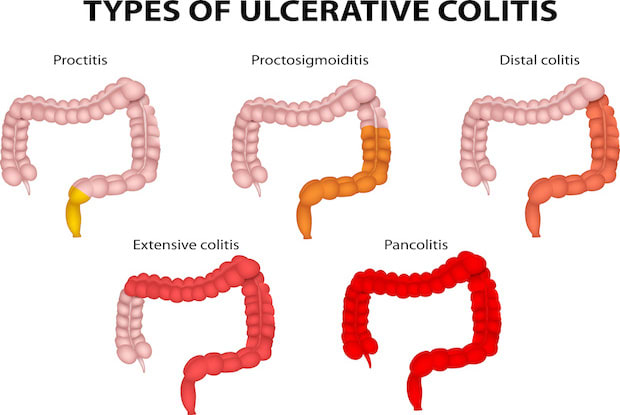Table of Contents
I. What is Ulcerative Colitis?
II. Types of Ulcerative Colitis
b. Left-Sided (Distal) Colitis
e. Acute Severe Ulcerative Colitis
III. What Causes Ulcerative Colitis?
IV. Symptoms of Ulcerative Colitis
V. Ulcerative Colitis Complications
VI. How is Ulcerative Colitis Treated?
a. Ulcerative Colitis Medications
What is Ulcerative Colitis?
Ulcerative colitis (UC) is a relatively uncommon condition that affects around 750,000 people in North America. [1] It is an inflammatory bowel disease (IBD) that affects the lining of the colon and rectum. Ulcerative colitis can develop at any time but is most commonly diagnosed when patients are aged between 15 and 35. UC affects both men and women equally, although it is more common in men after 50. UC is also more common in cities than in rural locations. [2]
Ulcerative colitis is a chronic disease with no known cure. However, treatments can be effective at reducing the symptoms of this condition. The symptoms of UC typically occur in cycles and almost half of UC patients are currently in remission. Of the remaining half, only around two percent have severe symptoms. [2]
Keep reading to learn the types, causes, and symptoms of ulcerative colitis and how it can be treated using medications such as mesalamine (Lialda or Asacol) and azathioprine (Imuran).
Types of Ulcerative Colitis
There are several different forms of ulcerative colitis. The type of UC you have depends on where the inflammation is located. Unlike Crohn’s disease, UC is limited to the colon.
Ulcerative proctitis is confined to the patient’s rectum. Usually, this affects less than six inches of the rectum and is one of the milder types of UC. The main symptoms of ulcerative proctitis are rectal pain, bleeding, and an increased urgency in bowel movements. [3] Left-sided (or distal) colitis starts at the rectum and extends through the sigmoid and into the colon. Common symptoms of this type of UC include pain and cramping on the left side of your abdomen, bloody diarrhea, and unexplained weight loss. [4] Proctosigmoiditis occurs when the inflammation involves the rectum and the lower end of the colon. Symptoms of proctosigmoiditis commonly include abdominal pain, cramps, bloody diarrhea, or an inability to move the bowels. This form of UC is sometimes combined with left-sided colitis, as the locations involved are very similar. Pancolitis (also known as pan-ulcerative colitis, total colitis or universal colitis) makes up around 20 percent of all UC cases. This form of UC affects the entire large intestine. People with pancolitis have often started with another form of UC that has then spread throughout their colon. [5] Acute severe ulcerative colitis is a rare form of UC that affects the entire colon. Symptoms of this condition include severe pain, fever, loss of appetite, bleeding, and severe diarrhea. [4] It is not known what exactly causes ulcerative colitis. However, it is believed that the condition is a result of an overactive immune system and occurs when the immune system malfunctions. Typically, the body’s immune system attacks and destroys foreign substances in the body, such as bacterium and viral infections. For people that have UC, the immune system can believe that food, helpful bacteria in the gut, and the cell lining are these foreign substances. This then causes white blood cells to attack the lining of your colon and intestines, causing inflammation and ulcers. [6] Nutrition can play a big part in the symptoms of UC and it is important that patients eat a healthy diet. The symptoms of ulcerative colitis vary depending on which type of UC you have. Symptoms typically flare up before going into longer periods of remission. However, there is no cure for UC and even if you go years without a flareup, the condition will still return. The primary symptom of the condition is bloody diarrhea. Other common signs and symptoms include: In addition to the above symptoms of ulcerative colitis, the condition can also lead to several more severe complications. These complications worsen if UC is not treated properly. Colon Cancer: Ulcerative colitis increases your risk of developing colon cancer in the future. This risk is increased if you have had UC for a long period of time, or if your entire large intestine is affected. It is likely that your doctor will perform a colonoscopy to check for colon cancer when you are diagnosed with UC. It is recommended to get screened for colon cancer every one to three years. [6] Liver Disease: Ulcerative colitis can cause your liver or bile ducts to become inflamed or cause scar tissue in the liver, leading to liver disease. Osteoporosis: Osteoporosis is a weakening of your bones. Around 60 percent of UC patients have thinner-than-normal bones. This results from colon inflammation making it more difficult to absorb calcium and vitamin D. Corticosteroids can also lead to osteoporosis. [7] Severe Bleeding: UC may cause severe bleeding, which in turn leads to anemia, a condition that causes a drop in the number of blood cells carrying oxygen. Bloody stools or diarrhea is a symptom of bleeding. [7] Dehydration: If your large intestine can no longer absorb sufficient amounts of fluids, you may become dehydrated and require liquids through an intravenous (IV) drip. [6] Toxic Megacolon: A toxic megacolon (also known as fulminant colitis) occurs when gas is trapped in the colon, causing it to swell. It can become so swollen that it eventually breaks and releases bacteria into the blood. [7] Perforated Colon: If the wall of the colon is severely weakened by inflammation or sores, then a hole may develop. This is often the result of toxic megacolon and can cause serious infections. Surgery is required to close a perforated colon. [7] Inflammation: Ulcerative colitis can cause inflammation across your body, including your skin, joints, and eyes. [4] The first treatment for ulcerative colitis is usually the medication 5-aminosalicylic acid (5-ASA), such as mesalamine (Lialda or Asacol). These medications work to control your symptoms by fighting inflammation in the body. Another common UC drug is Imuran (azathioprine). This medication works by suppressing your immune system, which causes the initial inflammation. As well as specific medications to treat ulcerative colitis, you may also be prescribed other medications, including corticosteroids, antibiotics, biologics, or immunosuppressants to help relieve your symptoms. If you have chronic, debilitating symptoms or have severe complications, then you may require surgery. Typically, this is a proctocolectomy, which involves removing your entire colon and rectum. As well as removing your colon, a new waste pathway will need to be created. This is either re-routed back to the end of your rectum or a small hole is created in your abdomen wall and drained into a bag. [8] The content provided in this article is based on thorough research and in some cases, reviewed by a medical professional. Our goal for the information is to provide helpful, general health informational. It is not intended as a substitute for professional medical advice.
a. Ulcerative Proctitis
b. Left-Sided (Distal) Colitis
c. Proctosigmoiditis
d. Pancolitis
e. Acute Severe Ulcerative Colitis
What Causes Ulcerative Colitis?

Symptoms of Ulcerative Colitis
Ulcerative Colitis Complications

How is Ulcerative Colitis Treated?
a. Ulcerative Colitis Medications
b. Ulcerative Colitis Surgery
